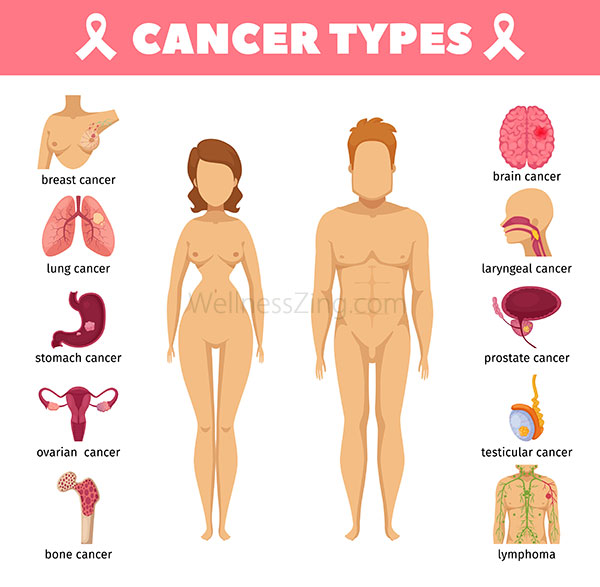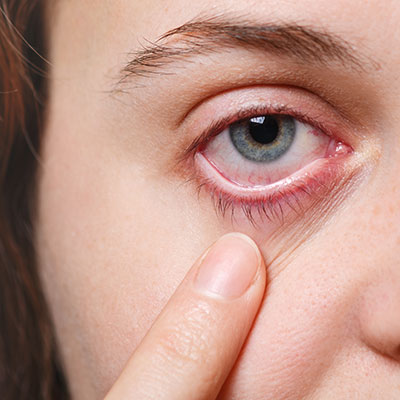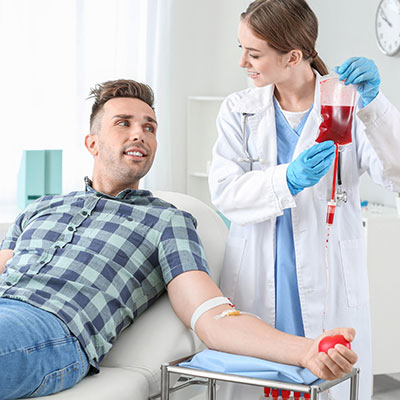Cancer is one of the deadliest diseases that takes the live of many people every year. This condition occurs due to uncontrolled growth of abnormal cells and tissues in the body named tumors. These tumors can be either cancerous and noncancerous. Cancer can commence almost anywhere and can adversely impact vital organs of the body. Where a few types of cancers develop slowly, others can develop very fast. In this article we will learn about cancer, its types, causes, symptoms and ways to diagnose, and treat it.
About Cancer and its Prevalence
Cancer is taking lives of more than a thousand people every year. It affects people in various forms. Though, this disease can happen to anyone, but the risk increases with age. It is mostly diagnosed in people who are above fifty years of age. Due to advanced screening, and medical treatment, it has become easier to treat different types of cancer.
Cancer is caused due to an uncontrolled expansion of abnormal cells in the body. These cells are called as cancer cells, tumor cells, and malignant cells. They have the ability to infect normal body tissues.
When these damaged cells don’t die, they become cancer cells and grow uncontrollably in the body. In this way cancer cells develop at a mass rate. The process by which these cells leave the area and grow in other regions of the body is called as “metastasis”.
Cancer is identified by the tissue from which the malignant cells are originated such as breast cancer, colorectal cancer, and lung cancer. Some of the common types of cancers that happens to men, women, and children are:
Men: Prostate cancer, colorectal cancer, and lung cancer
Women: Breast cancer, lung cancer, and colorectal cancer
Children: Leukemia, lymphoma, and brain tumors
The cause of cancer is based on various factors that includes age, race, gender, diet, genetics, and local environmental factors.
What are the causes of Cancer?
Below are the reasons that contributes to formation of Cancer in the body.
1. Genetics
Cancer is a hereditary disease. This implies that it is passes through genes. So, if your parents suffered from this disease, then there are chances that you are 5% to 10% more susceptible to develop this disease.
Modifications in the genes, can make a cell cancerous. It can increase the speed at which a cell can duplicate itself. Types of cancers that can be caused due to human genes are breast cancer, colorectal cancer, ovarian cancer, prostate cancer, melanoma cancer, and skin cancer.
2. Lifestyle
A person can also acquire Cancer due to exposure to harmful substances, that includes tobacco smoke that can cause damage to the DNA and result in genetic modifications. Over exposure to sun can even lead to changes in the genes, called mutations.
3. Exposure to toxins, and chemicals
People who are exposed to Benzene, nickel, asbestos, vinyl chloride, cadmium, N-nitrosamines, benzidine, cigarette smoke, asbestos, aflatoxin, and tobacco are susceptible to Cancer.
4. Ionizing radiation
Uranium, X-ray-emitting sources, radon, radiation received from alpha, beta, and gamma rays can lead to Cancer.
5. Pathogens
Human papillomavirus, Epstein-Barr virus, hepatitis viruses B and hepatitis viruses C, herpes virus, Schistosoma spp., Helicobacter pylori, Merkel cell polyomavirus, etc. are also responsible to causing Cancer in the body.
Risk factors associated with Cancer
There are certain factors that can increase your risk of developing Cancer in the body. Let us learn about them.
1. Red Meat
Consumption of red meat that includes beef, pork, and lamb is contributed as a high-risk factor for causing Cancers.
2. Processed meat
Processed meats such as smoked, salted, cured, or preserved meats can increase your risk of developing cancer. This is because cooking at high temperature results in the formation of cancer-causing compounds in the body.
3. Existing health issues
Another reason for development of cancer is due to existing health conditions that includes lack of exercise, obesity, severe inflammation, and hormones that are used for performing replacement therapy.
4. Use of Cell phone
According to World Health Organization (WHO), low energy radiation that is emitted by cell phones are considered to be carcinogenic and can increase the chances of developing Cancer in the body.
Common Symptoms of Cancer
The signs of cancer are dependent on the type of cancer, the affected area, and the location of its spread. When the Cancer is in initial stages, it is quite hard to detect any visible symptoms of the diseases. Its symptoms become more pronounced when it reaches to the advanced stage. Some of the common signs that indicates Cancer are:
- Change in bowel movement
- Change in bladder habits
- A persistent sore throat
- Unusual discharge from breasts
- Lump in the testicles, or breast
- Severe Indigestion
- Problem to swallow food
- Visible change in shape, size, shape, thickness, and color of a mole
- Irritating cough
- Unexplained weight reduction
- pain in abdomen
- pain in rectum
- Loss of appetite
- Pain in the bones or any other area of the body that worsens with passing time
- Obstinate fatigue, vomiting and nausea
- Persistent or recurrent low-grade fever
- Recurring infection that doesn’t get clear with normal treatment
If you are experiencing any of these conditions, it is better to get consulted by the doctor.
Types of Cancer and Cancer Treatment
Cancer can happen at any place in the body. There are several types of cancers. Each of these types has its subtypes that requires a different approach to treat it.
1. Leukemia
This type of cancer begins in blood-forming tissues in the body like the bone marrow. It causes flow of large numbers of abnormal blood cells into the blood. Symptoms include pain in joints, and bones, fatigue, dizziness, loss of appetite, fever, bleeding, easy bruising, shortness of breath, red spots on skin, bleeding nose, mouth ulcer, frequent infections etc. Treatment involves chemotherapy followed by blood transfusion, stem-cell transplant, and radiation therapy.
2. Bladder Cancer
This type of cancer is not very common and affects men as compared to women. Bladder is the empty, muscular organ present in the lower abdomen. This organ stores the urine. Bladder cancer begins in the urothelial cells in the body that forms the internal lining of the bladder.
Symptoms include dark urine, blood in urine, and frequent flow of urine, etc. On the basis of its stage, the treatment for this type of cancer involves surgery, chemotherapy, radiation therapy, and biological therapy.
3. Lymphoma
This cancer starts in the cells of the body’s immunity system. Symptoms include loss of appetite, night sweats, fatigue, swollen lymph nodes, weight loss, shortness of breath, and fatigue. Prescribed treatments for this type of cancer are Chemotherapy that uses medicines to kill cancer cells.
Radiation therapy that use high-intensity rays to kill cancer cells, and Immunotherapy that uses the immunity system of the body to attack cancer causing cells in the body. In severe cases, bone marrow transplantation, auto-transplantation surgery can be performed.
4. Brain Tumor
A brain tumor can develop in two forms such as cancerous, and non-cancerous. A person with this condition can experience seizures, headaches, personality changes, nausea, vomiting, and memory problems. Depending on the type, grade, size, and location of tumor, the treatment will be designed. Common treatments for this condition are Chemotherapy, Tomotherapy, Radiation therapy, or surgery called Craniotherapy.
5. Bone Cancer
Bone cancer is a cancer that starts in cells that forms the bones. It is categorized into two parts as primary bone cancer that happens in bone cells, and metastatic bone cancer that happens in others regions in the body and spreading to the bones.
Symptoms are pain in joints, and bones, bone fracture, swelling in bones, weight reduction, tiredness, etc. Treatment for this condition involves surgical elimination of the tumor, radiation, a stem cell transplant and chemotherapy.
6. Breast Cancer
This is a form of an invasive tumor that is formed in the mammary gland. It is diagnosed through biopsy, breast self-examination, mammograms, and specialized testing on breast cancer tissue. Women with breast cancer have a lump formation in their breast, or nipple discharge. Prescribed treatments to cure breast cancer are surgery, radiation therapy, chemotherapy, hormone therapy, and targeted therapy.
7. Lung Cancer
Lung Cancer begins in the lungs and causes spread of cancer-causing cells in the organ. It is classified as small lung cancer, and non-small lung cancer. Patients with lung cancer experiences pain in the chest, unusual bleeding during coughing, shortness of breath, and fatigue. Surgery, chemotherapy, radiation therapy, immunotherapy, and targeted drug therapy are used to treat varying stages of this condition.
8. Uterine Cancer
This type of cancer is seen in woman. Uterus is the place where the baby grows when a woman gets pregnant. Uterine cancer starts in the layer of cells that develops the internal lining of the hollow pelvic organ named uterus.
Symptoms include pain in the pelvis, abnormal menstruation, abnormal menstrual bleeding, and heavy menstruation. The main treatment performed in this condition is surgery that aims at removing the affected organ. Advance cases are treated with chemotherapy, and radiation.
9. Prostate Cancer
This type of cancer happens in the prostate gland of men. This gland resembles like a walnut and secretes seminal fluid. This fluid nourishes, and helps in the flow of sperm. The cancer begins to build from the gland cells and spreads by breaking away from a prostate tumor.
Symptoms of this cancer are pain in the bones, dribbling of urine, problem in maintaining stable flow of urine, urinary retention, frequent urination, weaker urinary flow, excessive urination at night. The advised treatment for this condition radiation therapy, surgery, chemotherapy, hormone therapy, and other treatments.
10. Rectal Cancer
Rectum lies at the lower end of the digestive-tract of a person. Rectal cancer, also called as Colon Cancer happens when the healthy cells in the rectum forms errors in their DNA. People who are over fifty years old are at a high risk of developing this type of cancer.
Symptoms are blood in stool, change in bowel movements, anemia, fatigue, abdominal pain, weight loss, excessive gas. The treatment depends on the location, severity, size and the extent of spread of the cancer. Based on these factors, your doctor can advise you surgery to remove the affected part, radiation therapy or chemotherapy.
11. Kidney Cancer
As the name suggest, this cancer begins in the kidney when healthy cells in either or both kidneys develop uncontrollably and form a lump or tumor in the organ. Renal cell carcinoma, is considered to the commonest forms of kidney cancer.
Symptoms are bloody urine, lump in abdomen, weight reduction, severe fatigue, and unexplained persistent fever. Possible treatments for this condition are surgery, targeted drug therapy, radiation therapy, and chemotherapy.
12. Liver cancer
Liver is an organ that is located in the upper region of the stomach, upper right area of abdomen, and below the abdomen. This cancer starts in the hepatocytes cells in the liver and this condition is referred to as hepatocellular cancer.
Symptoms are pain in the abdomen, bloating, itching, weight loss, fluid in the abdomen, and fatigue. Treatment advised are surgical removal of affected part of liver, chemotherapy, radiation, and liver transplant.
13. Pancreatic cancer
This type of cancer begins in the pancreas that is located at the rear end of the lower region of the stomach. Symptoms are seen as pain in abdomen, or mid-back region, fatigue, dark urine, yellow eyes, and skin, nausea, fluid in abdomen and loss of appetite. It is treated using medications (chemotherapy), radiation therapy, surgical means to remove pancreatic tumors, and palliative care.
How is the Cancer Diagnosed?
On suspecting any of the symptoms of cancers, you need to take assistance of an oncologist. A physical inspection, medical history, and details about symptoms are the initial and major steps to diagnose cancer. Screening tests are beneficial in detecting occurrence of a cancer at the initial stage when there are maximum chances for the cancer to get cured.
Some of these screening tests include breast examination, testicular examination, prostate examination, colon-rectal examination called as colonoscopy, mammography, endoscopy, biopsy, specific blood tests, urine tests, electrolyte levels etc. Imaging studies are also used to detect cell abnormalities that could lead to cancer.
CT Scan, MRI scans, X-rays, and ultrasound are tools used for examination. Radionuclide scanning is needed to inspect the areas such as lymph nodes, or interior of bones. This process involves IV injection of a radioactive substance to detect presence of any abnormal tissue. People who are suspicious of having cancer are advised to not delay and seek medical assistance as soon as possible.
How is the Cancer treated?
For the cancer treatment, you may also need to consult a surgeon, and radiation therapy specialist for effective diagnosis. An oncologist will use chemotherapy treatment, a surgeon will perform surgery, and the radiation therapy specialist will provide effective radiation therapies to treat the cancer. They may mutually consult with each other to form a comprehensive treatment plan to treat a specific cancer condition.
In addition to it, you may require assistance of a few other specialists depending on the type of cancer. For example, if you are suffering from uterine cancer, you may need to consult an ob-gyn specialist. In case of cancers that damages immunity system, you may be required to get assistance of an immunologist.
What type of complications can arise due to Cancer treatment?
Following are the complications that may arise due to ongoing treatment of cancer, that includes medication, and treatment protocols:
- Fatigue (both from cancer and its treatment)
- Anemia (both)
- Insomnia (both)
- Hair loss (from chemotherapy treatment and not from the treatment)
- Pain (both)
- Loss of appetite (both)
- Lymphedema (both)
- Nausea (both)
- Less Efficient Immune system (both)
How to prevent Cancer?
Many types of Cancers can be prevented by adopting healthy lifestyle, and not indulging in things that causes it. There are some of the effective preventive tips that will help you protect from this disease to a high extent.
- Stop smoking tobacco
- Avoiding over exposure to sunlight and always apply sunscreen before going in sun.
- Avoid exposure to chemicals by reducing use of chemical-enriched cosmetics etc.
- Avoiding coming in contact with specific types of cancer-causing pathogens, and viruses
- People like chemical workers, ionizing radiation researchers, X-ray technicians, and asbestos workers who work in industries where they are exposed to cancer-causing compounds should strictly follow safety precautions to lower their exposure to them.
- Reduce your exposure to cell phones. A good way to use it by using an earpiece. Reduce calls as much as possible.
- Perform regular check-ups
Conclusion
After heart disease, cancer is the second life-threatening disease that if left untreated can start to spread uncontrollably and quickly damage the vital organs of the body. At this stage, cancer is difficult to treat. Also cancer treatment is very costly. It is thus required to diagnose the disease and treat it at the initial stages to save your life.
If you liked this post, then do share it with your friends on social media. Also, you can write to us any of your queries, suggestions, and comments. We will be happy to address them soon.




















